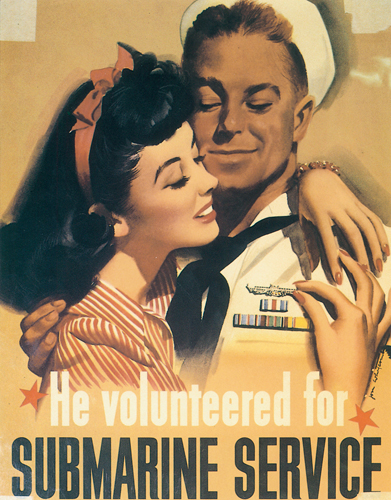Breeding Hatred for the Enemy


Posters like these largely inflated anti-Axis sentiments in America and led to more Americans in support for war involvement. Through the Office of War Information (OWI), Roosevelt instructed painters, printers, cartoonists, etc to demonize Hitler and the Japanese in their publications. Like these show, propaganda posters succeeded in personalizing World War II for Americans because Hitler stepping on the White House or preying greedily on "our homes" meant that this was not just a distant European problem.
Encouraging Portrayal of Allies


These types of propaganda glorified the idea of fighting alongside Britain and the rest of the Allied countries. Roosevelt hoped that through portrayal of foreign allies, he could prove to the American citizens that we were all in this together to save democratic ideals in the world. He encouraged them to think of World War II beyond their personal or national scale and presented it as a bigger international issue they had to face.
The Need to Work


Through propaganda that urged Americans to start working for the war, Roosevelt gained support for the war itself. America had just experienced the worst depression in its country's history and that also propelled people's willingness to get back to full work mode. By the 1940s, working was advertised to both men and women. Although workers in the industry were initially reluctant to mass produce weapons, it could be said that propaganda like the ones above greatly helped them overcome that dilemma.
Enlisting Soldiers

Enlistment posters were perhaps the most important out of the six types of propaganda. As matters with Britain's shipping escorts leaned towards the need for American men, Roosevelt urged enlistment for anyone eligible. By making it sound appealing like "choose your own branch of the service", more and more men applied to become a soldier. The second poster here portrays the navy seal as courageous and admirable, even getting attention from his significant other.
Call to Sacrifice Luxury


This was an especially important type of propaganda as the war progressed. From "To the Brink" chapter in Freedom from Fear, we learn that England is short of money although they were still desperate for supplies from America. This meant that America had to pay for the war when England's money supply exhausted. With this fear turning into a reality, Roosevelt advised American citizens to conserve any resources they used for themselves.
Fight for America and Democracy


Finally, there were of course propaganda encouraging American unison for one common purpose: winning the war. These kinds of posters often included the American flag somewhere and illustrated ideals that were historically important to any Americans. By pointing out that they were fighting for democracy, equality, etc, Roosevelt pulled the public to his side.
The use of propaganda controlled by the OWI eliminated some of the stress on President Roosevelt. The devastation of World War I had left most Americans unwilling to cooperate with him in the effort of war. Therefore, propaganda became ever-more crucial to unite the nation in preparation for the next world war.
Sources:
http://www.nationalww2museum.org/learn/education/for-students/ww2-history/at-a-glance/propaganda-posters.html?referrer=https://www.google.com/
https://www.gilderlehrman.org/history-by-era/world-war-ii/essays/every-citizen-soldier-world-war-ii-posters-american-home-front
I like the fact that you closely examined all of the central types of propaganda that were present during the World War II era and did not focus solely on one type during this era. You did a wonderful job connecting the artwork of each type of poster to its original motive, and through your analysis I am now better able to understand the psychological influence of the propaganda over many American citizens, given the current scenario. However, in order to contextualize this time period in American history on a deeper level, I would have also liked to know what was the most common type of propaganda used and why it was the most prevalent. Also, understanding what groups of people created the largest amount of propaganda could also provide reasoning for the style of the public war promotion artwork. For further information, I recommend reading this particular article: http://www.pbs.org/wgbh/amex/goebbels/peopleevents/e_propaganda.html
ReplyDeleteThis post was interesting because it shows the different opinions of the people that were talked about back then. It's interesting to see that Americans seemed to be expecting war in their country at any moment even though it was never close to happening.
ReplyDeleteThis was a great post! It showed different kinds of propaganda that also appealed to different people on a psychological level. It is really interesting to see how much time and effort was spent to create different kinds of posters to appeal to different parts of society. I liked the way you talked about several kinds, which gave me a more exemplified view of propaganda in general.
ReplyDelete